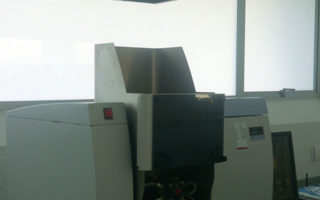The soil and leaf tissue analysis laboratory serves as technical support to establish the fertilizer recommendations and necessary amendments for the crop.
This laboratory has the necessary personnel, infrastructure, and quantification equipment to carry out the characterization of soils and leaf tissue corresponding to sugarcane crops located in the geographic valley of the Cauca River, with the capacity to provide reliable and traceable results. according to the guidelines of the ISO 9001 quality management system.
The main equipment that the laboratory has are:
atomic absorption spectrometer
Atomic Absorption Spectrometry (EAA) is an instrumental analysis technique, capable of detecting and quantitatively determining most of the elements included in the periodic system with high precision. Its popularity is due to its specificity, sensitivity, and ease of operation. This equipment is used for the determination of Calcium, Magnesium, Potassium, Sodium, Iron, Copper, Manganese and Zinc and is applicable to different matrices such as soils, leaf tissue, cane juices, ashes, honey, bagasse and stillage, among others.

UV-Vis Spectrophotometer
This technique is based on the measurement of absorption of ultraviolet or visible radiation by certain molecules. The radiation corresponding to these regions of the electromagnetic spectrum causes electronic transitions at wavelengths characteristic of the molecular structure of a compound. The Spectrophotometer is used in the determination of Sulfur, Boron, organic matter, Phosphorus, Dextrans, Starches among others.

KJELDAHL automatic distiller
The Kjeldahl Method is a chemical analysis process to determine the nitrogen content of a chemical substance, it consists of three stages:
- Digestion: conversion of Nitrogen into ammonium ion by heating (approximately 400ºC) in a digestion block with prior addition of sulfuric acid and catalyst (copper(II) sulfate), which trigger the conversion of nitrogen in the sample to ammonium.
- Distillation: Stripping of ammonia with steam and subsequent solubilization in an acid solution of known concentration.
- Assessment: measurement of the amount of acid neutralized by dissolved ammonia, which indicates the amount of Nitrogen present in the initial sample.

NIR spectrometer
Near-infrared spectroscopy studies the interaction of electromagnetic radiation with matter. The near infrared includes the light segment of wavelengths between 800 and 2600 nm of the electromagnetic spectrum and analyzes the absorption of energy in this region by the functional groups of the sample molecules. This technique is used as a secondary method for the determination of organic matter and polysaccharides.












